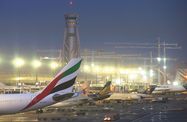Long seen as a future powerhouse in the emirate’s diversified economy, Dubai’s aviation sector is starting to live up to expectations. Local carriers have been posting strong profits and expanding their network of routes, though the risk of turbulence remains.
Some regional carriers have seen profits nosedive over the past year, as a result of the disruptions caused by volcanic eruptions in Iceland, freezing conditions in Europe that saw airports close across the continent during the winter and, more recently, political upheaval in some areas of the Middle East.
However, on May 10 Emirates airline announced its results for the 12 months ending March 31, unveiling a 52% jump in net profits to $1.5bn. To put this into perspective, in 2010 all of the world’s airlines recorded combined profits of just $16bn, according to data issued by the International Air Transport Association.
Emirates also posted near-industry-high seat occupancy rates, with an average of 80% of capacity filled, and saw its cargo division boost its revenue by 27.6% to $2.4bn, thanks to an 11.8% increase in freight transported, with 1.8m tonnes hauled.
Low-cost carrier flydubai has also been posting some good figures, though it is still working to gain momentum and revenues. Established in 2008, the airline is looking to declare a profit by 2012, having invested heavily in new aircraft and facilities over the past three years.
According to flydubai’s CEO, Ghaith Al Ghaith, the airline is planning to expand the number of routes it flies from 36 to at least 40 by the end of this year, and up to 70 by 2016. The airline will also increase the number of planes it operates from 16 to more than 50 in the coming five years.
Despite being hit by high fuel prices, which account for up to 40% of costs, Ghaith said he was confident of increasing revenue and routes. “We are certainly on track to make a profit next year,” he told local daily Emirates 24/7 on May 10. “Over the next few years we want to increase our number of destinations and serve all the lucrative routes in the 4.5-hour flight radius.”
Air traffic across the UAE – and in Dubai in particular – is on the rise, with almost 56,000 take-offs and landings recorded in April, a 6.7% increase on the same month in 2010. Of the total, just under half of these movements took place in Dubai, according to the UAE General Civil Aviation Authority.
The volume of traffic is set to increase next year when Dubai’s new international airport becomes fully operational. With maximum passenger handling capacity of 160m a year, Al Maktoum International Airport (AMIA) will be the world’s biggest airport and is also expected to become the busiest. According to Paul Griffiths, the CEO of Dubai Airports – the agency that manages both AMIA and Dubai International Airport – the emirate’s aviation industry is set to benefit from increased liberalisation, GDP growth and more mobile populations in emerging markets.
“Dubai is extremely well positioned to capitalise on that growth,” he said on May 3. “We are eight hours from two-thirds of the world’s population and on the doorstep of two of the most dynamic markets in the world – India and China.” The combination of rallying tourism and Dubai’s established role as a trading centre linking economies in the Far East, Europe, Africa and North America is also a key advantage for the local aviation industry and the national economy, he said.
Dubai’s rapid development as an international aviation centre and the strong performance of its local carriers has drawn more than its share of criticism, with some in the industry claiming that government-owned Emirates, in particular, has enjoyed advantages other than those of location. Rivals have suggested Emirates has received substantial government subsidies, an avenue that is restricted to many European carriers due to stringent competition regulations.
While denying that the growth of Emirates is due to government support rather than a result of its own efforts, the airline’s chairman, Sheikh Ahmed bin Saeed Al Maktoum, acknowledges that its aggressive policies could ruffle feathers. “I’m sure this will make a lot of people unhappy but the market is there to grow,” he said in mid-May. “Airlines in Europe don’t want to see us there because we are giving them competition. But we get good market share because of the product.”
With plans to increase the number of routes it serves, Emirates is looking to schedule more flights to destinations in North and South America, Australia and Asia, Sheikh Ahmed said. This spreading of Emirates’ wings will have to be measured against market conditions, with the aviation industry particularly susceptible to fluctuations in fuel prices and economic sentiment.
With costs well up so far this year, Emirates may be hard pressed to keep profits at their 2010 level, with the airline’s CEO, Tim Clark, telling UK newspaper the Daily Telegraph on May 10 that the first four months of the year had seen $280m added to the carrier’s fuel bill. That said, Dubai’s airlines should continue to build strongly on recent results across this year and further benefit from having the world’s largest airport to call home in 2012.

